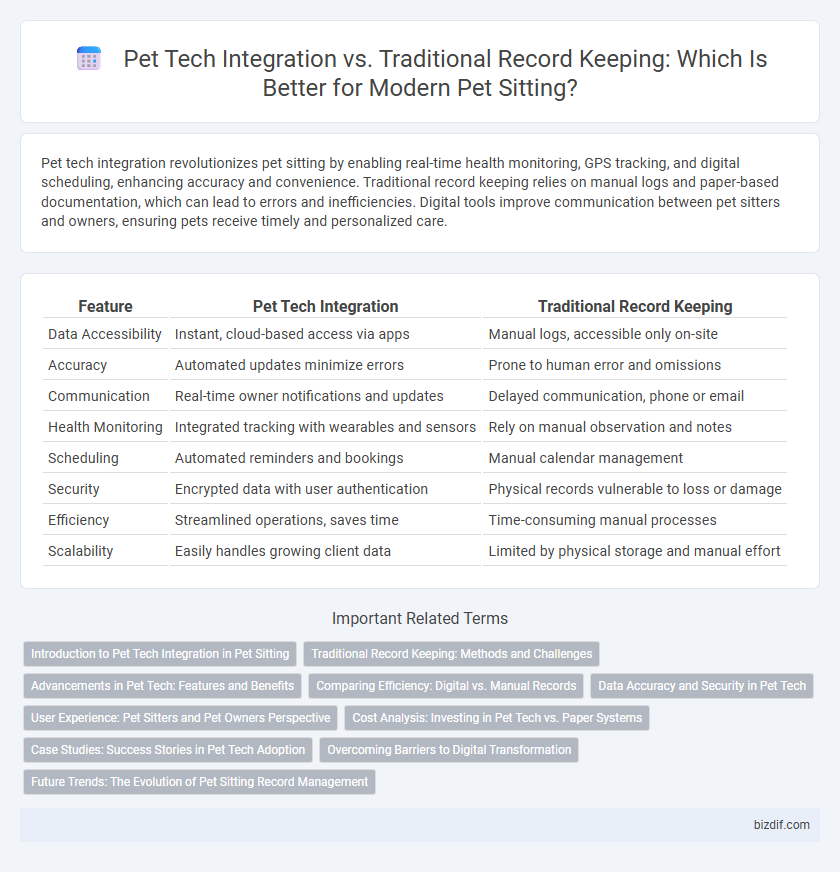Pet tech integration revolutionizes pet sitting by enabling real-time health monitoring, GPS tracking, and digital scheduling, enhancing accuracy and convenience. Traditional record keeping relies on manual logs and paper-based documentation, which can lead to errors and inefficiencies. Digital tools improve communication between pet sitters and owners, ensuring pets receive timely and personalized care.
Table of Comparison
| Feature | Pet Tech Integration | Traditional Record Keeping |
|---|---|---|
| Data Accessibility | Instant, cloud-based access via apps | Manual logs, accessible only on-site |
| Accuracy | Automated updates minimize errors | Prone to human error and omissions |
| Communication | Real-time owner notifications and updates | Delayed communication, phone or email |
| Health Monitoring | Integrated tracking with wearables and sensors | Rely on manual observation and notes |
| Scheduling | Automated reminders and bookings | Manual calendar management |
| Security | Encrypted data with user authentication | Physical records vulnerable to loss or damage |
| Efficiency | Streamlined operations, saves time | Time-consuming manual processes |
| Scalability | Easily handles growing client data | Limited by physical storage and manual effort |
Introduction to Pet Tech Integration in Pet Sitting
Pet tech integration in pet sitting enhances monitoring through smart collars, GPS tracking, and health monitoring devices, offering real-time updates and detailed activity logs. Unlike traditional record keeping that relies on manual notes and paper-based documentation, digital platforms streamline data management and improve communication between sitters and pet owners. This technology-driven approach increases accuracy in pet care records and ensures timely interventions for health or behavioral issues.
Traditional Record Keeping: Methods and Challenges
Traditional pet sitting record keeping relies on physical logs, handwritten notes, and manual appointment scheduling, which can lead to errors and lost information. These methods often require significant time investment for updates and retrieval, impacting efficiency and accuracy. Challenges include limited accessibility, increased risk of miscommunication, and difficulty in maintaining comprehensive pet health and behavior histories.
Advancements in Pet Tech: Features and Benefits
Advancements in pet tech have revolutionized pet sitting by offering real-time monitoring, health tracking, and automated scheduling, enhancing the overall care quality. Smart collars and GPS devices provide accurate location data and activity insights, reducing risks associated with traditional record keeping. These technologies improve communication between pet sitters and owners, increase transparency, and ensure prompt responses to any health or behavioral changes.
Comparing Efficiency: Digital vs. Manual Records
Digital pet tech integration streamlines record keeping by enabling real-time updates, automated reminders, and easy access to pet health data, which significantly boosts efficiency compared to traditional manual records. Manual record keeping often leads to delays, errors, and difficulties in tracking pet histories, reducing overall service quality. The use of cloud-based platforms and mobile apps in pet tech optimizes data management, enhances communication, and supports better decision-making for pet sitters.
Data Accuracy and Security in Pet Tech
Pet tech integration in pet sitting ensures higher data accuracy by automating record keeping and minimizing human errors common in traditional methods. Advanced encryption and cloud-based storage enhance data security, protecting sensitive client and pet information from breaches. Real-time updates and digital logs provide reliable, accessible records, revolutionizing trust and accountability in pet care services.
User Experience: Pet Sitters and Pet Owners Perspective
Pet tech integration enhances user experience for both pet sitters and pet owners by providing real-time updates, streamlined communication, and easy access to pet care records through mobile apps and cloud platforms. Traditional record keeping often involves manual logs and physical documents, which can lead to miscommunication and delays in sharing important information about the pet's health and activities. Digital solutions improve transparency, reduce errors, and increase convenience, fostering greater trust and satisfaction among all parties involved in pet sitting.
Cost Analysis: Investing in Pet Tech vs. Paper Systems
Investing in pet tech for pet sitting services often results in long-term cost savings by automating scheduling, billing, and client communication, reducing labor costs compared to traditional paper systems. Initial expenses for software subscriptions and devices may be higher, but the efficiency gained minimizes errors and improves data accessibility, offsetting manual paperwork and storage costs. Paper systems incur ongoing costs in printing, filing, and physical storage, making pet tech integration a more cost-effective and scalable solution for growing pet sitting businesses.
Case Studies: Success Stories in Pet Tech Adoption
Case studies reveal that pet tech integration significantly enhances record accuracy and accessibility compared to traditional record keeping in pet sitting. Digital platforms enable real-time updates on pet health, behavior, and activities, leading to improved caregiver communication and pet well-being. Success stories highlight increased client satisfaction and streamlined operations through automated scheduling, health monitoring, and instant data sharing.
Overcoming Barriers to Digital Transformation
Pet tech integration offers real-time monitoring and streamlined communication, contrasting sharply with the limited accessibility and manual errors prevalent in traditional record keeping. Overcoming barriers to digital transformation requires investing in user-friendly platforms and ensuring staff training to enhance adoption rates. Embracing cloud-based systems improves data accuracy and client trust, driving efficiency and growth in pet sitting services.
Future Trends: The Evolution of Pet Sitting Record Management
Pet tech integration is revolutionizing pet sitting record management by enabling real-time updates, GPS tracking, and automated health monitoring, replacing traditional paper-based logs and manual entry systems. Future trends indicate an increasing adoption of AI-driven platforms that personalize care plans based on pet behavior and health data, enhancing service accuracy and pet safety. Cloud-based applications streamline communication between pet sitters and owners, ensuring secure, accessible, and comprehensive record keeping for improved operational efficiency.
Pet tech integration vs Traditional record keeping Infographic

 bizdif.com
bizdif.com